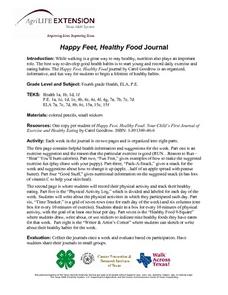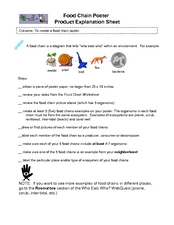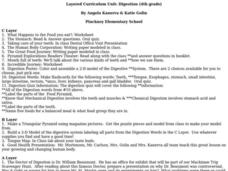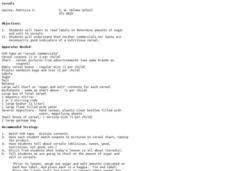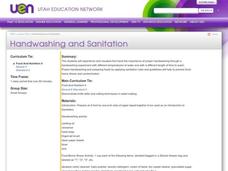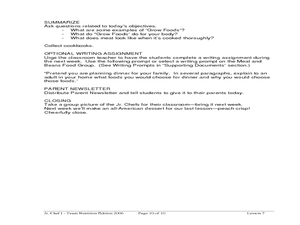Curated OER
Genetically Modified Foods
Learners explain what genetically modified foods are and how they are created. Students use appropriate vocabulary to describe and effectively discuss the benefits of, and potential risks of, genetically modified foods.
Curated OER
Food Challenge
Students identify poor eating habits and create a plan to overcome them. For this eating habits lesson, students identify four eating habits they have and research the implications of poor eating habits. Students find healthy...
Curated OER
Healthy Food Choices
Students, working in groups, role play skits highlighting healthy eating habits and physical activities.
Curated OER
Happy Feet, Healthy Food Journal
Fourth graders record their physical activities and eating habits in a journal. They place their answers in the workbook, Happy Feet, Healthy Food. They sketch and write about their weekly healthy habits.
Curated OER
Interconnected Food Web
In this fish worksheet, students make connections between fish and it food and enemies to create a food web. Students label the connections.
Curated OER
Food Chain Poster Instructions
In this food chain worksheet, students follow a set of 9 steps to create a food chain poster. Page has no additional activities.
Nemours KidsHealth
Healthy Snacking: Grades 9-12
Snacks—even the word can conger up a hunger. Rapidly growing teens, especially, rely on snacks to get them from one meal to the next. After reading a series of articles about nutrition and healthy snack choices, pupils fill out a report...
Curated OER
Digestion
Fourth graders answer the question what happens to the food you eat? They complete a worksheet about the food you eat. They discuss the different types of teeth that we have. Students complete digestion poster in which they color and...
Curated OER
Plants and Animals
Students find common needs between plants and animals. In this plants and animals lesson students compare that both plants and animals need food and water. They also find the differences between plant and animal needs.
Curated OER
Cereals
Young scholars watch television commercials, then analyze the nutritional value of the cereals. In this health and nutrition instructional activity, the teacher shows students several cereal commercials, then the young scholars describe...
Curated OER
Handwashing and Sanitation
Students experience and visualize first hand the importance of proper hand washing through a hand washing experiment with different temperatures of water and with a different length of time to wash. They prevent food-borne illness and...
Curated OER
Delicious Dinners by Jr. Chefs
Students create a protein-rich dinner. In this nutrition lesson, students brainstorm foods that are rich in protein. Students make burritos and identify the color of meat when it is cooked thoroughly.
Curated OER
Understanding Oceans
Students investigate how ocean currents affect our world. In this ocean currents lesson, students perform an experiment to show how cold water is near the poles and warm water is near the equator. Students use water, food coloring,...
Curated OER
Pyramid Panic Lesson
Students research human health by identifying fatty and sugary foods. In this food choices lesson, students discuss the five food groups and examine the healthiest choices from each group. Students utilize the web to complete a health...
Curated OER
Protists - The Protozoans
Five pages provide thorough coverage of three protozoans: euglena, amoebae, and paramecia. For each, junior biologists read factual text, label the organism, and write answers to several questions. This neatly organized assignment is...
American Chemical Society
Defining Dissolving
Physical science investigators mix sugar and food coloring into different cups of water and cooking oil to compare how the solid and liquid behave in each. As the introduction to this unit on dissolving, it is relevant.
Curated OER
Using Your Teeth
In this Using Your Teeth worksheet, students read information about teeth and then complete the labels for a diagram about teeth. Students also think about the differences between human and animal teeth and design an information leaflet...
Curated OER
ESOL Consumer Education
Students discuss the importance of reading and understanding price
tags, labels and expiration dates. They Compare/contrast the significance and practice of reading food labels, expiration dates and prices of food items in students'...
Curated OER
Movement concepts
Students recognize the connection between food labels and exercise. In this health lesson, students understand how many times they need to dribble to work off a snack. Students answer questions about the exercise.
TED-Ed
Sugar: Hiding in Plain Sight
Did you know that you can find added sugars in three-quarters of the foods you find in grocery stores? Invite your learners to consider how much sugar exists in the food products we eat on a day-to-day basis, as well as to learn about...
Curated OER
Stats on Reduced-Fat
Middle schoolers demonstrate an understanding of the Five-Number Summary and Box-Plots after analyzing data from nutrition labels, forming a hypothesis and supporting it. They decide if there is a significant difference between reduced...
Curated OER
Using Details from the Text
Explore non-fiction comprehension strategies with your class. They will visualize daily activities and label a 4 circle Venn diagram with related phrases. They must identify the overlapping sections as "main ideas," then complete a...
Curated OER
Reading Labels For Fat Types
Students analyze a variety of cooking oils to determine the amount and types of fats included in each.



